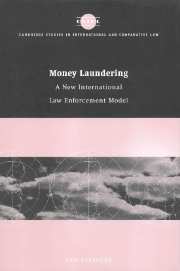Book contents
- Frontmatter
- Contents
- Preface
- Table of treaties and agreements
- List of abbreviations
- Part I New instruments in the fight against acquisitive crime: confiscation of proceeds from crime and criminalisation of money laundering
- Part II The prevention of money laundering
- Part III Jurisdiction over money laundering
- Part IV International co-operation in combating money laundering
- Epilogue
- Bibliography
- Index
- CAMBRIDGE STUDIES IN INTERNATIONAL AND COMPARATIVE LAW
Part II - The prevention of money laundering
Published online by Cambridge University Press: 16 October 2009
- Frontmatter
- Contents
- Preface
- Table of treaties and agreements
- List of abbreviations
- Part I New instruments in the fight against acquisitive crime: confiscation of proceeds from crime and criminalisation of money laundering
- Part II The prevention of money laundering
- Part III Jurisdiction over money laundering
- Part IV International co-operation in combating money laundering
- Epilogue
- Bibliography
- Index
- CAMBRIDGE STUDIES IN INTERNATIONAL AND COMPARATIVE LAW
Summary
Preventive measures, though often intrinsically connected with the repressive fight against money laundering, have a distinctly different purpose from that of penal measures. It has already been shown that financial measures which centre on the role of financial institutions in the fight against money laundering can have two functions. On the one hand, there is the type of financial anti-money laundering measure that was developed in the United States, the importance of which lies in the information that is provided to the government, both in terms of an instant intelligence flow through the imposition of reporting obligations and in terms of a database that financial institutions are forced to keep through record-keeping obligations. The Swiss-type of financial anti-money laundering measures, on the other hand, are more directed towards the prevention of the misuse of financial institutions. The international financial anti-money laundering measures, and accordingly the preventive legislations of most countries that have implemented these international measures, integrate both functions. They are nevertheless referred to as ‘preventive legislation’ as the emphasis of the aforementioned international instruments is clearly on the preventive side.
The term ‘financial legislation’ can moreover be confusing as the application field of some domestic preventive legislation has been expanded to other than financial institutions and professions. The application field will be studied not only in ratione personae but also in ratione materiae, that is, with regard to the range of predicate offences. Subsequently, the role that has been attributed to financial institutions, financial intelligence units and to the supervisory authorities will be scrutinised.
- Type
- Chapter
- Information
- Money LaunderingA New International Law Enforcement Model, pp. 131 - 132Publisher: Cambridge University PressPrint publication year: 2000



